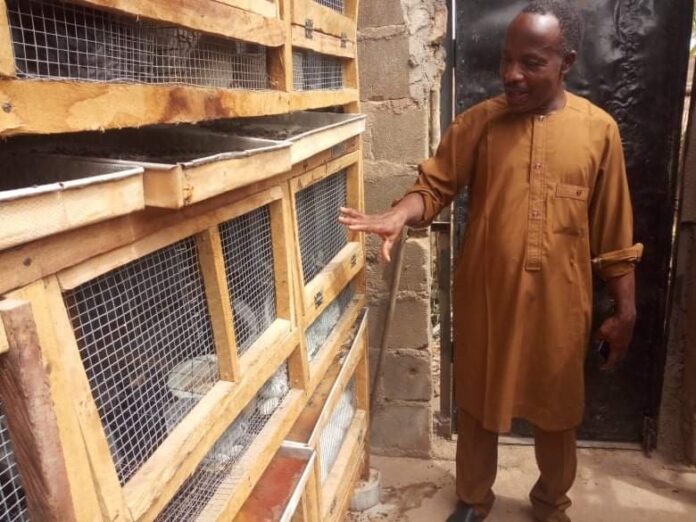Caleb Gochin, one of the rabbit farmers in Plateau in his farm.
By Marie-Therese Nanlong
Jos – Livestock farming the world over is a lucrative branch of agriculture, many farmers pay attention to poultry, fishery, cattle, pig, goats and snail among other animals.
Engaging in rabbit farming is something some see as fun, not knowing that rabbits are not just pets but keeping them could improve one’s economic status.
Compared to other livestock farming, rabbit farming has the advantage of minimal investment requirements and the rabbits reproduce faster.
Although poultry, cattle and piggery are prominent in Plateau State, the skyrocketing prices of poultry feeds has turned many poultry to rabbit rearing.
From New Zealand, California, Chinchilla, Angora to the Flemish Giants and other breeds, the new revolution spread among residents who have turned to breeding rabbits in commercial quantities.
READ : Akwa Ibom State IGR closed strong in 2020 despite COVID-19
Ezekiel Sunday who recently ventured into rabbit farming attested to the gains of the trade said, “Rabbit farming is one of the agricultural businesses youths can venture into. Rabbits meat is consumed yearly, there is fur production, pharmaceutical uses of rabbits, they are even kept as pets.”
Another rabbit farmer, Caleb Gochin who cleared the air about the phobia in eating rabbit meat added, “It is just like any other animal, if you take care of them, they look good. There are some cows that if you see, you will say oh mine, why should you slaughter such? In some areas, cows are worshipped but we eat them here.”
On the viability of the business he stressed, “we have an association, Plateau Rabbit Breeders’ Association. We meet once in a while to discuss issues of rabbitry in the State.
We have both male and female members, with the challenges people are facing in poultry, the cost of feeds and all of those, many of the women fall back to rabbitry.
“In rabbits you can feed them with anything like grasses, vegetables, leftovers of food, peels etc but the only thing is that if you are going into large scale, you may have to augment with formulated feeds to enhance their growth.
“Rabbits will give you about eight to ten kids, if you buy an eight weeks old rabbit today, in the next three months when she is about five months, you can cross the doe and buck, it takes only 30 days for them to litter so when your rabbit is about six months, you have like five kids and in another five months or so, those kids are also matured enough to also litter. If those kids also have their kids, you know what you will get within a year.”
HAVE YOU READ A BOOK TODAY?

A former poultry farmer, Rachael Umaru lamented that she lost her investment to bird flu and when she was wondering what to do, she was introduced to rabbit farming so she converted her space to the new business.
Her words, “the prices of chicks and feeds kept increasing, the fluctuation in prices made it difficult for us to make gain, just as we are battling with these, bird flu entered and I lost all my investment. I was so confused until a neighbor suggested rabbit rearing.
“I was skeptical because I thought people keep rabbits as pets but when I got the first batch of colony, I knew rabbit farming is a goldmine we are yet to explore.
“Starting a rabbit farm does not require high capital and is not time-consuming. Rabbits are friendly and a good source of meat and fur production, their coat is also a good source of income for the farmer.
RELATED STORY : Many farmers are not going to farm due to insecurity – ECWA
However, it was learnt that prices of day old chicks fluctuate between N200 and N420, those of poultry feeds range from between N5,500 and N7,000 depending on the company but rabbits can be fed with a variety of grasses such as elephant, Napier grass, timothy grass, potato leaves and peels such as pineapple, dried cassava, yam, vegetables like carrots, lettuce, cabbage, and pellets made from maize, millet, groundnuts, or a simple formation of livestock feeds.
















